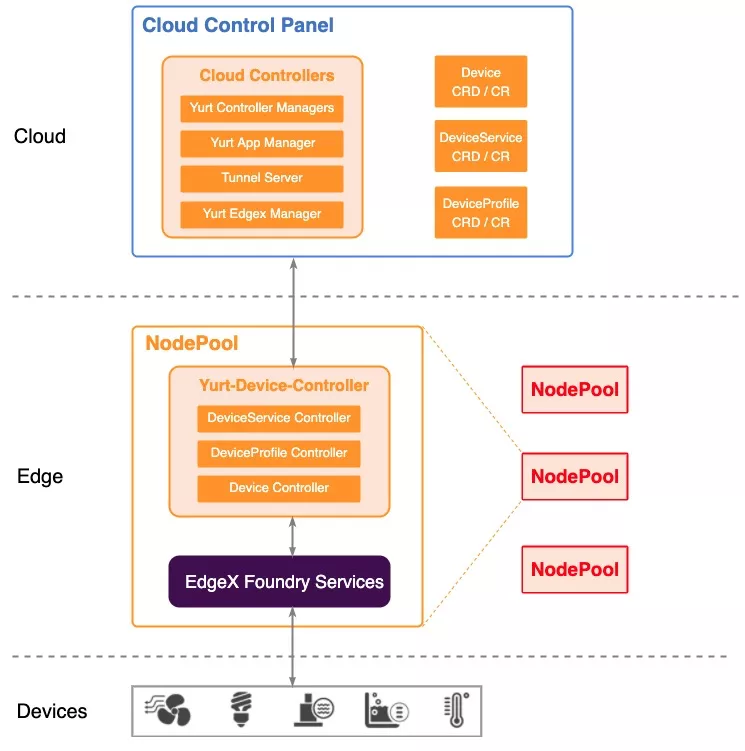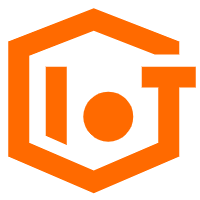By Jia Xiexing (from VMware), He Linbo (from Alibaba Could)
OpenYurt V0.5.0 was released on September 27, 2021. Kubernetes-native, non-intrusive, and scalable management standards for edge devices are proposed for the first time in the new release. This enables the seamless integration of the Kubernetes business load model and the IoT device management model. At the same time, OpenYurt (together with VMware) promotes the realization of EdgeX Foundry as the first implementation of the cloud-native device management model. It reduces the complexity of deploying and managing EdgeX Foundry on Kubernetes and improves the management efficiency of edge devices.
When we use Kubernetes to meet the demands in edge computing scenarios, the existing solutions are either to change the system architecture (such as packaging the control plane and kubelet) or to significantly modify the core components (such as blending device management in kubelet).
It was inspired by the Unix philosophy, “Do one thing and do it well.” The OpenYurt community believes Kubernetes should focus on the management of computing resources and containers, while edge devices can be managed by adopting existing edge computing platforms.
Therefore, the OpenYurt community defines generic Kubernetes CRDs that act as intermediaries between OpenYurt and edge platforms. All the existing edge platforms, such as EdgeX Foundry, can be integrated into OpenYurt by implementing custom controllers for CRDs. These CRDs also allow users to manage edge devices in a declarative manner and provide users with a Kubernetes-native experience of edge device management.
In summary, the cloud-native management of edge devices has the following features: management in a Kubernetes-native manner, non-intrusive integration, and extensive in binding edge computing platforms.
The cloud-native management capabilities of edge devices include the following points:
First, the yurt-edgex-manager component is introduced to manage the lifecycle (including the installation, deployment, deletion, and update) of EdgeX Foundry from the node pool dimension in the OpenYurt cluster. You can manage the EdgeX Foundry system by simply editing EdgeX CRD. We recommend deploying the EdgeX Foundry system using the node pool as the dimension. The following figure shows the principle:

Second, the yurt-device-controller component is introduced as the connector between the Kubernetes system and the edge computing platform, such as EdgeX Foundry. This component enables users to manage edge devices using Kubernetes CRs. Each yurt-device-controller instance corresponds to an EdgeX Foundry service in the same node pool. The following figure shows the overall deployment architecture.

The integration of OpenYurt and EdgeX Foundry is implemented based on the operation mechanism of the open-source community. It is led by companies, such as VMware and Alibaba Cloud, and shaped up with the contributions of community members. The open-source governance process and mechanism of the OpenYurt community is improved during the implementation of the project, and the ecological collaboration between upstream and downstream services in edge computing is empowered.
The parallel design and development of multiple projects show the advantages of Kubernetes-native, non-intrusive, and scalable design concepts and provide support for the landing and subsequent evolution of the cloud-native management of edge devices.
Community members are trying out this capability, and the OpenYurt community is making demo videos of relevant capabilities. You are welcome to follow and submit your suggestions.
The latest version of OpenYurt improves the device management capability of native Kubernetes in edge scenarios and optimizes the governance capability in edge scenarios. In the future, the OpenYurt community will continue to work hard in aspects, including edge device management, project usability, and unitized governance capability. Thanks again to all the members from VMware, Intel, Zhejiang University, Telecom e Cloud, Li Auto, IBM, and Alibaba Cloud. Interested parties are welcome to work with us to build a stable, reliable, and cloud-native edge computing platform.
Please see this link and this link for more information about OpenYurt

508 posts | 48 followers
FollowAlibaba Cloud Native Community - May 4, 2023
Alibaba Cloud Native Community - June 30, 2023
Alibaba Cloud Native Community - March 14, 2022
Alibaba Cloud Native Community - August 4, 2023
Alibaba Container Service - November 7, 2024
Alibaba Developer - March 3, 2022

508 posts | 48 followers
Follow Link IoT Edge
Link IoT Edge
Link IoT Edge allows for the management of millions of edge nodes by extending the capabilities of the cloud, thus providing users with services at the nearest location.
Learn More Function Compute
Function Compute
Alibaba Cloud Function Compute is a fully-managed event-driven compute service. It allows you to focus on writing and uploading code without the need to manage infrastructure such as servers.
Learn More Elastic High Performance Computing Solution
Elastic High Performance Computing Solution
High Performance Computing (HPC) and AI technology helps scientific research institutions to perform viral gene sequencing, conduct new drug research and development, and shorten the research and development cycle.
Learn More Quick Starts
Quick Starts
Deploy custom Alibaba Cloud solutions for business-critical scenarios with Quick Start templates.
Learn MoreMore Posts by Alibaba Cloud Native Community